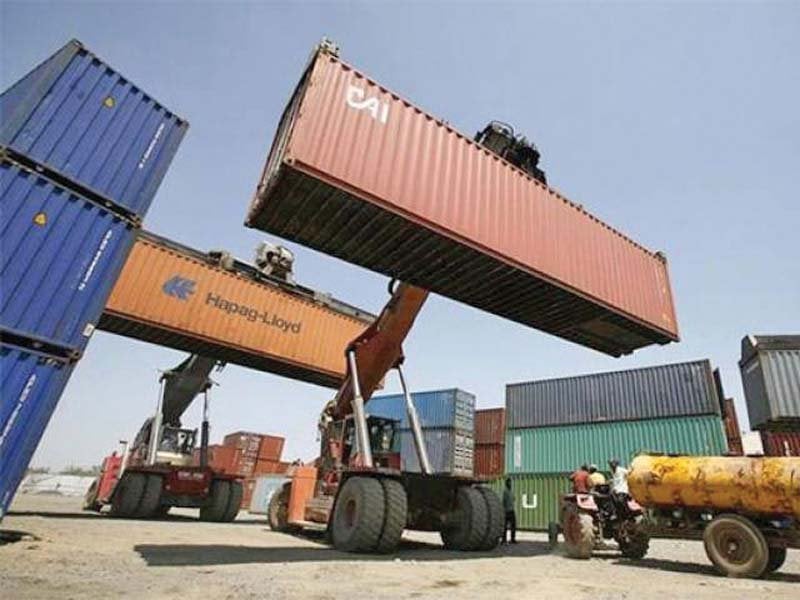
The decline was also accompanied by a decline in the value of exports, of approximately 3%, in February 2018 over the value reported in January 2018.
Therefore, in February 2018, there was a decline in both import and export values. However, as imports reported a greater decline in February 2018, the increase in trade deficit was lower than that in January 2018.
On the other hand, imports have increased every month in terms of the period-to-period growth rate since July 2016, the last instance a decrease in period-to-period growth rate in imports was reported.
Trade with neighbour: In absence of payment mechanism, Pakistan loses Iran market
Further, in recent years, imports in February have been typically lower than that in January. Although currency devaluation and import restrictions may have been attributed to the decline in the import value, the volatility in trade must be analysed.
Further investigation at the commodity level suggests that imports have declined in value in February 2018, relative to January 2018, for all products except LNG, petroleum crude and raw cotton. The largest declines have been reported in the imports of power generating machinery, palm oil and petroleum products.
Similarly, exports have also declined in value for all products except for cotton yarn and sugar. The largest decline is reported for fruits, rice, knitwear and ready-made garments. A decline in the export value is a cause for concern as recent months have witnessed currency devaluation and provision of export subsidies.
This clearly suggests that exports are highly susceptible to short-term incentives and the growth in exports, as a result of such incentives, is unlikely to be sustainable. Diversification in the export basket, with particular emphasis on less price sensitive and higher value manufactured goods, must be emphasised upon in the next trade policy.
Considering the quantity exported, it is important to note that the quantity of major export commodities such as rice, ready-made garments, and leather products have also declined in February 2018 over the quantities reported in January 2018.
There has been a decline in the quantity of imports of almost all major commodities in February 2018 over January 2018. For instance, the imports of palm oil decreased by 18%, petroleum products decreased by 20%, plastic materials decreased by 12% and iron and steel scrap decreased by more than 36%.
The sharp decline in imports of essential commodities can likely be a result of procedural delays as well as obstacles to trade. Although the demand of inventory as well as price fluctuations may influence the volatility of import demand, delays and lack of custom facilitation increase volatility.
One of the poorest indicators for Pakistan in the World Bank’s Doing Business is ‘Trading across Borders’. The time and the cost to trade in Pakistan, for both exporters and importers, is higher than the South Asian average. Higher the costs of documentation and greater the time to trade, lower the frequency as firms lower their average costs of trading.
According to the data provided by the SBP, imports from China have decreased by more than 25% in February 2018 over January 2018, imports from the US have declined by more than 19% and imports from Saudi Arabia have declined by more than 9%.
Similarly, there was a decline in exports to the aforementioned destinations between January 2018 and February 2018. As Pakistan has increased its import dependency during the recent years, restriction of imports of crucial inputs may have adversely impacted exporters.
Such fluctuations in trade patterns, unlikely to be influenced by global events, suggests that short-term measures may alter trade patterns on a month-to-month basis, but not necessarily result in a favourable outcome in the long-run. Although sharp fluctuations have been reported for the month-to-month growth rate of imports, the period-to-period numbers have increased. Therefore, trade deficit will likely continue its rising trend in the next fiscal year.
Ecuador offers Pakistan market access to S America
Global trade faces several challenges that are likely to impact Pakistani consumers and producers. For instance, the trade war between the US and its major trading partners is likely to impact the global supply and demand of commodities that are frequently traded between the countries.
Steel and aluminum may observe a supply glut as the US, one of the largest importers of both commodities, restricts its imports by imposing higher tariff rates. Trade retaliation may distort world prices of crucial commodities, particularly at a time when Pakistan is dependent upon such imports for infrastructural development under CPEC.
Uncertainties in trade policies may adversely impact industrial growth at a time when the economy is not only facing a looming external debt crisis but a possible IMF programme.
As mentioned earlier, trade costs are likely to be amplified by higher costs and procedural obstacles faced by both exporters and importers. The higher cost and time required at the port to clear custom inspections not only substantially increases the cost of trading but also reduces the frequency with which traders participate in international trading activities.
This may explain the higher volatility reported in trade data. Although improved communication channels have been introduced to facilitate traders, the number of trade documents must also be reduced. Further, traders, custom officials as well as clearing agents must not only be better informed on procedures but also be better trained to comply with the requirements more efficiently, making the documentation procedures less burdensome for them.
Unfortunately, there has been an over reliance on short-term programmes to correct the deficit in the trade balance. Long-term programmes that improve the business environment for firms trading across borders are the need of the hour. The government may gain temporary relief from subsidies and currency depreciations. However, as the data suggests, such relief programmes make trade more volatile and are less likely to alleviate the current dilemma on the balance of trade.
The writer is Assistant Professor of Economics and Research Fellow at CBER, IBA
Published in The Express Tribune, April 9th, 2018.
Like Business on Facebook, follow @TribuneBiz on Twitter to stay informed and join in the conversation.

















COMMENTS
Comments are moderated and generally will be posted if they are on-topic and not abusive.
For more information, please see our Comments FAQ